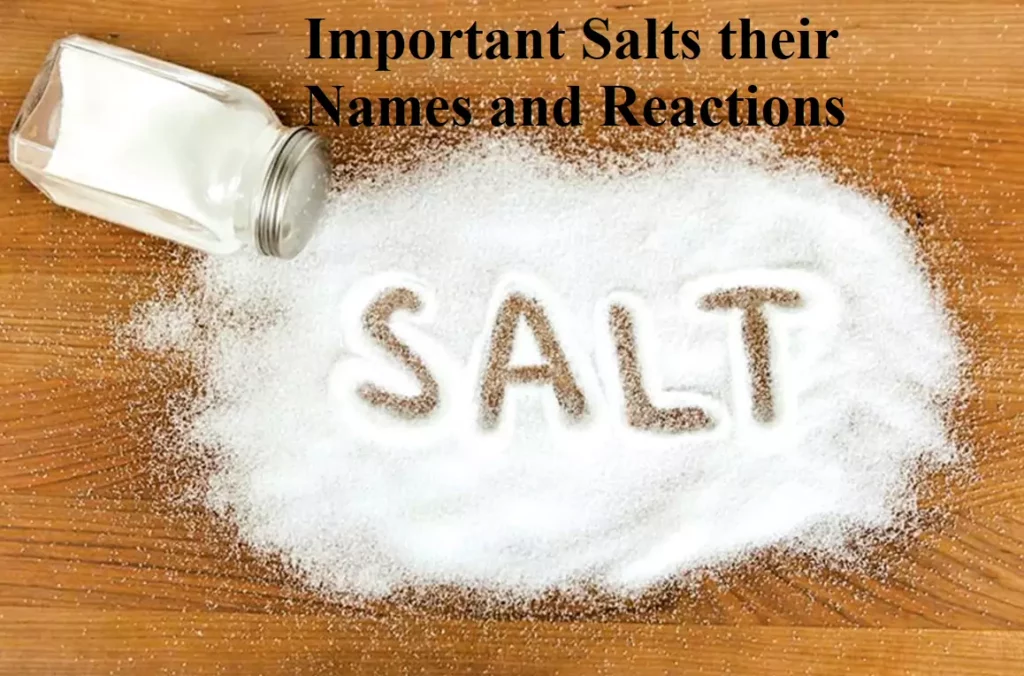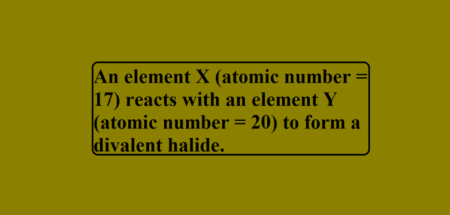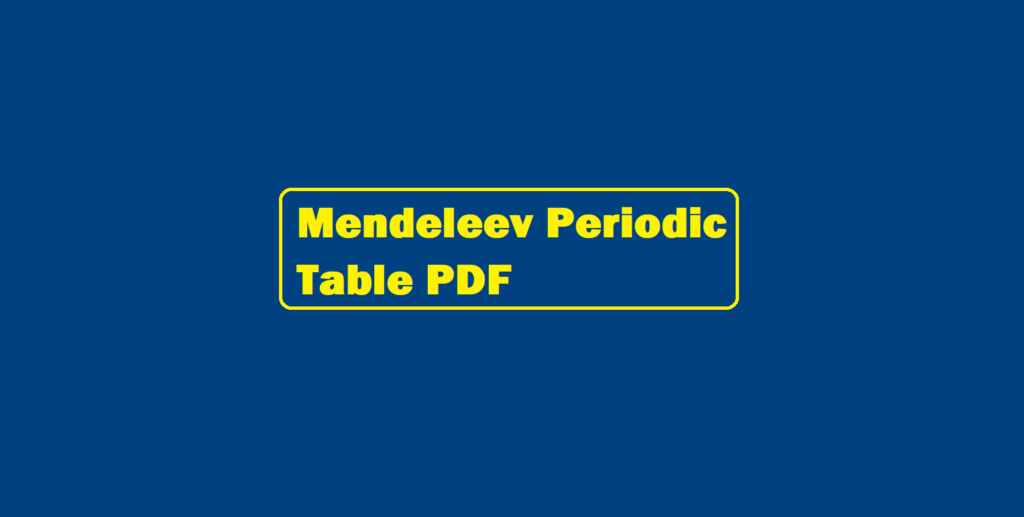Important Salts their Names and Reactions
SALTS
A Salt is an ionic compound that is made up of two groups of oppositely charged ions. The ion with a positive charge is called a cation, and the one with a negative charge is called an anion.
Classification of Salts
(1) Normal salts: A normal salt is obtained by complete neutralization of an acid by a base.
NaOH + HCl → NaCl + H2O
(2) Acid salts: Acid salts are derived by the partial replacement of hydrogen ions of an acid by a metal. When a calculated amount of a base is added to a polybasic acid, acid salt is obtained, as follows.
NaOH + H2SO4 → NaHSO4 + H2O
(3) Basic salts: Basic salts are formed by the partial replacement of hydroxide ions of a diacidic or triacidic base by an acid radical. A basic salt may further react with an acid to give a normal salt.
Pb(OH)2 + HCl → Pb(OH)Cl + H2O
Diacidic base Basic salt
| Family of Salts: Salts can be classified into the following types: Normal or Neutral Salts – A salt that is formed by the complete replacement of the replaceable hydrogen ions of an acid by a metal ion or ammonium ion is called a normal salt. Examples: Neutral Salts: Strong Acid + Strong base pH value is 7. Examples: NaCl, CaSO4 Acidic Salts: Strong Acid + weak base pH value is less than 7. Examples: NH4Cl, NH4NO3 Basic Salts: Strong base + Weak acid pH value is more than 7. Examples: Na2CO3, CH3COONa. |
Important Salts their Names and Reactions
Neutralization
The reaction between an acid and a base to form salt and water is called a neutralization reaction.
Acid + Base → Salt + Water
(i) Hydrochloric acid reacts with sodium hydroxide to form sodium chloride and water.
HCl + NaOH → NaCl + H2O
(ii) Sodium sulphate and water are formed when sulphuric acid reacts with sodium hydroxide (a base).
H2SO4 + 2NaOH → Na2SO4 + 2H2O
(iii) Calcium chloride is formed along with water when hydrochloric acid reacts with calcium hydroxide (a base).
2HCl + Ca(OH)2 → CaCl2 + 2H2O

Reaction Of Acid With Metal Oxides
Metal oxides are basic in nature. Thus, when an acid reacts with a metal oxide both neutralize each other. In this reaction, respective salt and water are formed.
Acid + Metal Oxide → Salt + Water
(i) Sulphuric acid reacts with zinc oxide, zinc sulphate, and water are formed.
H2SO4 + ZnO → ZnCl2 + H2O
(ii) Copper oxide (II), a black metal oxide reacts with dilute hydrochloric acid to form a blue-green coloured copper chloride (II) solution.
CuO + 2HCl → CuCl2(aq) + H2O
Important Salts their Names and Reactions
Common Salt
(i) Chemical name: Sodium Chloride (NaCl)
(ii) Common salt is a neutral salt and can be prepared in the laboratory by the reaction of sodium hydroxide and hydrochloric acid.
NaOH(aq) + HCl(aq) → NaCl(aq) + H2O(aq)
(iii) It is an important raw material for products of daily use such as NaOH, baking soda, washing soda, and bleaching powder.
Sodium Hydroxide
(i) Preparation: It is obtained by the electrolytic decomposition of a solution of sodium chloride (brine). In the process of electrolytic decomposition of brine (Brine: aqueous solution of sodium chloride), brine decomposes to form sodium hydroxide. In this process, chlorine is obtained at the anode and hydrogen gas is obtained at the cathode as by-products. This whole process is known as the Chlor-Alkali process (i.e. ‘Chlor’ for Chlorine and ‘Alkali’ for Sodium Hydroxide).
2NaCl + 2H2O → 2NaOH + Cl2 + H2

Washing Soda
(i) Chemical formula: Na2CO3.10H2O
(ii) Sodium hydrogen carbonate, on heating decomposes to give sodium carbonate with the release of Carbon dioxide gas. Re-crystallisation of sodium carbonate produces washing soda.
2NaHCO3 → Na2CO3 + H2O + CO2
Na2CO3 + 10H2O → Na2CO3. 10H2O
Uses
(i) Used in glass, soap, and paper industries.
(ii) Employed in the manufacture of sodium compounds such as borax.
(iii) As a household cleansing agent.
(iv) In paper and soap/detergent industries.
(v) For the softening of water.
(vi) A mixture of NaCO3 and K2CO3 is used as a fusion mixture.
(vii) In textile industry and petroleum refining.
Important Salts their Names and Reactions
Baking Soda
(i) Chemical formula: NaHCO3
(ii) It is produced on a large scale by treating a cold and concentrated solution of sodium chloride (brine) with ammonia and carbon dioxide.
NaCl + H2O + CO2 + NH3 → NH4Cl + NaHCO3
(iii) On heating, it decomposes to give sodium carbonate with the evolution of carbon dioxide.
2NaHCO3 → Na2CO3 + H2O + CO2
Uses
(i) Used as an antacid to treat acidity of the stomach.
(ii) Used to make baking powder, which is used in the preparation of cakes, bread, etc.
(iii) Used in soda-acid fire extinguishers.
Bleaching Powder
(i) Bleaching powder is manufactured from chlorine gas.
(ii) It is produced by the action of chlorine on dry slaked lime [Ca(OH)2].
Ca(OH)2 + Cl2 → CaOCl2 + H2O
(iii) It is represented as CaOCl2
Uses
(i) For bleaching cotton and linen in the textile industry and for bleaching wood pulp in the paper industry.
(ii) Used for disinfecting drinking water to make it free of germs.
Plaster of Paris
It is prepared by heating gypsum at 373 K. On heating, it loses water molecules and becomes calcium sulphate hemihydrate (CaSO4.1/2 H2O) which is called Plaster of Paris.
CaSO4.2H2O → CaSO4.½ H2O + 1½ H2O
Gypsum Plaster of Paris
Uses
(i) Used in hospitals as plaster for supporting fractured bones in the right position.
(ii) Used as a fire-proofing material.

The water of Crystallisation
(i). Water molecules that form a part of the structure of a crystal are called water of crystallization.
(ii). The salts which contain water of crystallization are called hydrated salts.
(iii) Every hydrated salt has a fixed number of molecules of crystallization in its one formula unit. For Example CuSO4.5H2O, Na2CO3.10H2O, CaSO4.5H2O, and FeSO4.7H2O.
Important Salts their Names and Reactions


